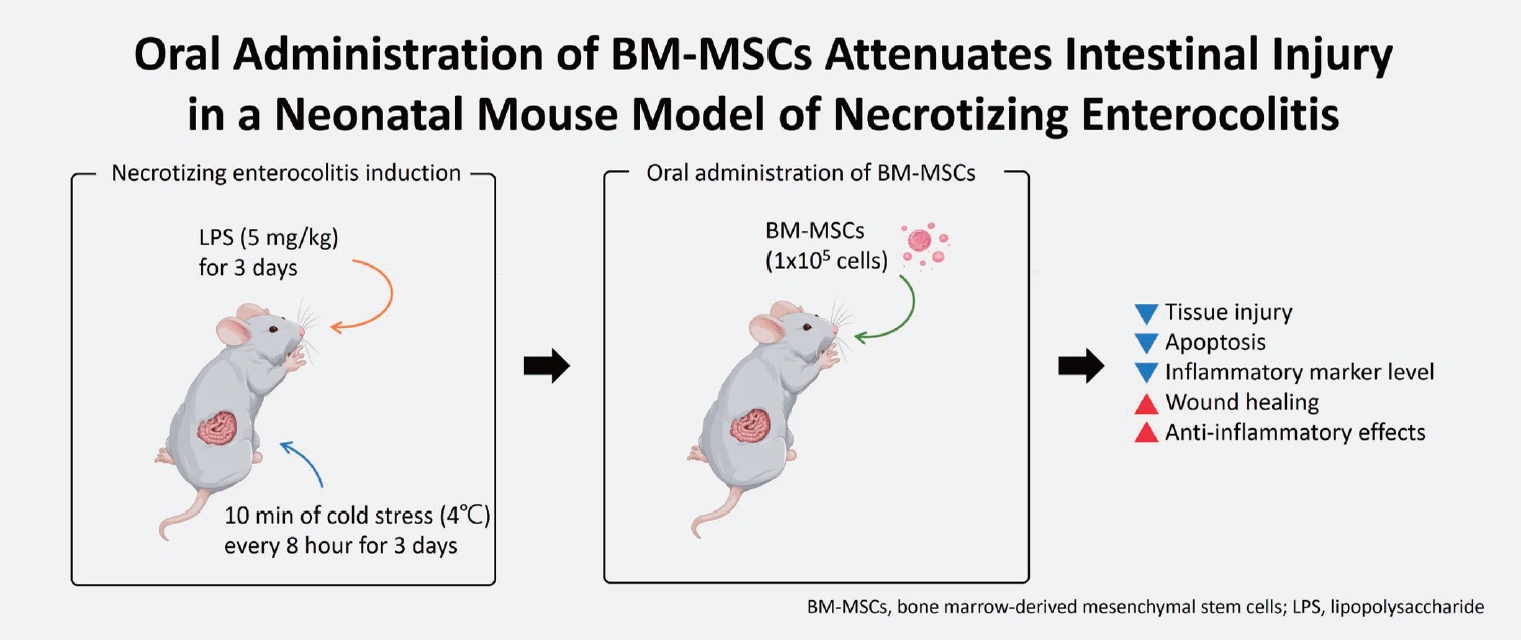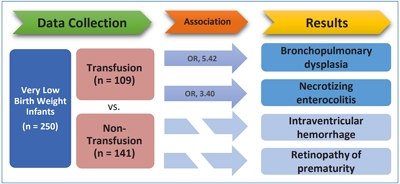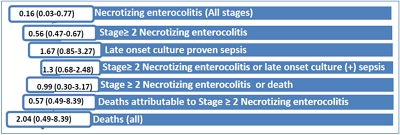Search
- Page Path
-
- HOME
- Search
- Original Article
- Neonatology (Perinatology)
- Oral administration of bone marrow-derived mesenchymal stem cells attenuates intestinal injury in necrotizing enterocolitis
- Yeong Seok Lee, Yong Hoon Jun, Juyoung Lee
- Clin Exp Pediatr. 2024;67(3):152-160. Published online February 19, 2024
-

Question: What is the optimal dose of bone marrow-derived mesenchymal stem cells (BM-MSCs) for treating necrotizing enterocolitis (NEC), and is orally administered BM-MSC effective?
Findings: High (1×106 cells) or multiple BM-MSC doses showed similar effects as low (1×105 cells) doses of intraperitoneally administered BM-MSCs. Furthermore, orally administered BM-MSCs were as effective as intraperitoneally administered BM-MSCs.
Meaning: Orally administered low-dose BM-MSCs are a potential treatment for NEC.
- Effect of red blood cell transfusion on short-term outcomes in very low birth weight infants
- Eui Young Lee, Sung Shin Kim, Ga Young Park, Sun Hyang Lee
- Clin Exp Pediatr. 2020;63(2):56-62. Published online February 6, 2020
-

Question: Does RBC transfusion affect the short-term outcomes of VLBW infants?
Finding: The results showed that RBC transfusion was significantly related to the incidence of BPD (OR, 5.42; P<0.001) and NEC (OR, 3.40; P=0.009).
Meaning: Careful consideration of the patient’s clinical condition and appropriate guidelines is required before administering RBC transfusions.
- Synbiotics use for preventing sepsis and necrotizing enterocolitis in very low birth weight neonates: a randomized controlled trial
- Ozge Serce Pehlevan, Derya Benzer, Tugba Gursoy, Guner Karatekin, Fahri Ovali
- Clin Exp Pediatr. 2020;63(6):226-231. Published online February 5, 2020
-

Background: Probiotics and prebiotics have strain-specific effects on the host. Synbiotics, a mixture of probiotics and prebiotics, are proposed to have more beneficial effects on the host than either agent has alone.
Purpose: We performed a randomized controlled trial to investigate the effect of Lactobacillus and Bifidobacterium together with oligosaccharides and lactoferrin on the development of necrotizing enterocolitis (NEC) or sepsis...
- The relation between serum levels of epidermal growth factor and necrotizing enterocolitis in preterm neonates
- Heba Mostafa Ahmed, Nsreen Mostafa Kamel
- Clin Exp Pediatr. 2019;62(8):307-311. Published online March 15, 2019
-

Purpose: Necrotizing enterocolitis (NEC) is one of the most serious complications of prematurity. Many risk factors can contribute to the development of NEC. The epidermal growth factor (EGF) plays a major role in intestinal barrier function, increases intestinal enzyme activity, and improves nutrient transport. The aim of this study was to assess the role of epidermal growth factor in the...
- Review Article
- Neonatology (Perinatology)
- Fetal and preterm infant microbiomes: a new perspective of necrotizing enterocolitis
- Yong-Sung Choi, In Gyu Song
- Clin Exp Pediatr. 2017;60(10):307-311. Published online October 20, 2017
-
Necrotizing enterocolitis (NEC) is a devastating condition of hospitalized preterm infants. Numerous studies have attempted to identify the cause of NEC by examining the immunological features associated with pathogenic microorganisms. No single organism has proven responsible for the disease; however, immunological studies are now focused on the microbiome. Recent research has investigated the numerous bacterial species residing in the body...
- Necrotizing enterocolitis in newborns: update in pathophysiology and newly emerging therapeutic strategies
- Young Youn Choi
- Clin Exp Pediatr. 2014;57(12):505-513. Published online December 31, 2014
-
While the survival of extremely premature infants with respiratory distress syndrome has increased due to advanced respiratory care in recent years, necrotizing enterocolitis (NEC) remains the leading cause of neonatal mortality and morbidity. NEC is more prevalent in lower gestational age and lower birth weight groups. It is characterized by various degrees of mucosal or transmural necrosis of the intestine....
- Original Article
- Fecal calprotectin concentration in neonatal necrotizing enterocolitis
- Jung Min Yoon, Ju Yi Park, Kyung Ok Ko, Jae Woo Lim, Eun Jeong Cheon, Hyo Jeong Kim
- Clin Exp Pediatr. 2014;57(8):351-356. Published online August 25, 2014
-
Purpose Among the many factors associated with acute intestinal mucosal infection, numerous studies have proposed the usefulness of fecal calprotectin. The aim of this study was to evaluate the usefulness of fecal calprotectin in the diagnosis of necrotizing enterocolitis (NEC).
Methods We collected 154 stool samples from 16 very low birth weight and premature newborns at the Konyang University Hospital neonatal intensive care...
- Analysis of the association between necrotizing enterocolitis and transfusion of red blood cell in very low birth weight preterm infants
- Seon-Yeong Bak, Sihyoung Lee, Jae-Hong Park, Kyu-Hee Park, Ji-Hyun Jeon
- Clin Exp Pediatr. 2013;56(3):112-115. Published online March 18, 2013
-
Purpose To investigate the association between necrotizing enterocolitis (NEC) and red blood cell transfusions in very low birth weight (VLBW) preterm infants.
Methods We studied were 180 VLBW preterm infants who were admitted to the neonatal intensive care unit of CHA Gangnam Hospital from January of 2006 to December of 2009. The subjects were divided into 2 groups: an NEC group (greater than...
- Review Article
- An update on necrotizing enterocolitis: pathogenesis and preventive strategies
- Jang Hoon Lee
- Clin Exp Pediatr. 2011;54(9):368-372. Published online September 30, 2011
-
Necrotizing enterocolitis (NEC) is one of the most critical morbidities in preterm infants. The incidence of NEC is 7% in very-low-birth-weight infants, and its mortality is 15 to 30%. Infants who survive NEC have various complications, such as nosocomial infection, malnutrition, growth failure, bronchopulmonary dysplasia, retinopathy of prematurity, and neurodevelopmental delays. The most important etiology in the pathogenesis of NEC...
- Original Article
- Analysis of prognostic factors of laparotomy for necrotizing enterocolitis in extremely low birth weight infants
- Jin Kyu Kim, Yi Sun Kim, Hye Soo Yoo, So Yoon Ahn, Hyun ju Seo, Seo Heui Choi, Soo Kyung Park, Yu Jin Jung, Myo Jing Kim, Ga Won Jeon, Soo Hyun Koo, Kyung-Hoon Lee, Yun Sil Chang, Won Soon Park
- Clin Exp Pediatr. 2010;53(2):167-172. Published online February 15, 2010
-
Purpose : With improved survival of extremely low birth weight infants (ELBWI), there is an increase in the incidence of necrotizing enterocolitis (NEC) requiring laparotomy, and the risk of morbidity and mortality in these ELBWI is increased. Thus, we determined the prognostic factors in ELBWI who underwent laparotomy for NEC. Methods : We retrospectively reviewed the medical records of 35 ELBWI... -
- Gastrointestinal surgery in very low birth weight infants : Clinical characteristics
- Ji Eun Kim, Hye Soo Yoo, Hea Eun Kim, Soo Kyoung Park, Yoo Jin Jeong, Seo Heui Choi,, Hyun Joo Seo, Yun Sil Chang, Jeong Meen Seo, Won Soon Park, Suk Koo Lee
- Clin Exp Pediatr. 2009;52(3):295-302. Published online March 15, 2009
-
Purpose : To report our experience of gastrointestinal (GI) operations (OP) performed in very low birth weight infants (VLBWI) and to evaluate their clinical characteristics. Methods : Among the 1,117 VLBWI admitted to the SMC neonatal intensive care unit from November 1994 to February 2007, the medical records of 37 infants who underwent GI OP (except inguinal hernia OP) and 1,080... -
- Case Report
- Primary peritoneal drainage as a treatment for perforated necrotizing enterocolitis with bacterial peritonitis in an extremely low birth weight infant : a case report
- Wook Sun Choi, Il Hong Moon, Jang Hoon Lee, Seung Hwa Lee, Byung Min Choi, Baik-Lin Eun, Young Sook Hong, Joo Won Lee
- Clin Exp Pediatr. 2006;49(7):800-804. Published online July 15, 2006
-
Necrotizing enterocolitis(NEC) is the most common life-threatening surgical emergency in neonates, and remains a major cause of morbidity and mortality. In addition to conventional laparotomy, intraperitoneal drains have been used for the treatment of perforated NEC, especially in extremely low birth weight(ELBW) infants. We report a case of perforated NEC with bacterial peritonitis in an ELBW infant managed with primary... -
- Original Article
- Risk factors and clinical characteristics of necrotizing enterocolitis in full-term newborns
- Young Mi Jeoung, Hyun Gon Je, Sang Hee Son
- Clin Exp Pediatr. 2006;49(5):489-493. Published online May 15, 2006
-
Purpose : The purpose of this study was to determine those factors which could contribute to the development of necrotizing enterocolitis(NEC) in fullterm. Methods : We retrospectively reviewed the medical record of 20 full-terms with NEC(≥modified Bell's staging criteria IIa) who were admitted to the Neonatal Intensive Care Unit of Il Sin Christian hospital from January 1998 through July 2005, and... -
- Effects of Intestinal Ischemia on Intestinal Mucosal Damage and Effects of Interleukin-10 in Young Murine Model
- Young-Shil Park, Dong-Chul Kim, Chung-Sik Chun
- Clin Exp Pediatr. 2004;47(3):319-324. Published online March 15, 2004
-
Purpose : Intestinal vascular ischemia is the most probable pathogenesis in the development of necrotizing enterocolitis in prematures. The authors studied the histology of intestinal mucosal damage by clamping the superior mesenteric artery in 35 rats, and, analyzed the histologic scores between young rats(I) and adult rats(II) groups according to clamping times(15, 30 and 60 minutes) and compared the effect... -
- A Clinical Observation of 23 Cases of Necrotizing Enterocolitis
- Ok Young Kim, Eun Ju Jeong, Min Jeong Kim, Mi Yeon Park, Son Sang Seo
- Clin Exp Pediatr. 1995;38(7):886-894. Published online July 15, 1995
-
Purpose : We observed risk factors, clinical findings, diagnosis and treatment of NEC in 23 cases in order to try to prevent developement of, and improve the prognosis of necrotizing enterocolitis(NEC) in the future. Methods : 23 cases of NEC who were admitted to the NICU of Ilsin Christian Hospital between Jan 1992 and June 1994 were studied. Data about birth... -
- Case Report
- A Case of Necrotizing Enterocolitis Associated with Cow and Soy Milk Intolerance
- Sang Soo Roh, Young Il Park, Sang Il Lee
- Clin Exp Pediatr. 1992;35(6):862-866. Published online June 15, 1992
-
A case of necrotizing enterocolitis was associated with cow and soy milk intolerance in a term infant. The infant developed symptoms and radiologic findings-pneumatosis intestinalis and portal vein gas-after ingestion of cow and soy milk. Vomiting and diarrhea recurred with reintroduction of either cow or soy milk several times. The infant remained asymptomatic with a good growth rate on breast... -
- Original Article
- Neonatal Necrotizing Enterocolitis.
- Min Sook Um, Jae Won Huh, Yun Joo Chung
- Clin Exp Pediatr. 1989;32(4):518-524. Published online April 30, 1989
-
We made a review on the 12 cases of neonatal necrotizing enterocolitis admitted to the nursery of Gospel hospital of Kosin Medical College from September, 1984 to June, 1987 and reseults were; 1) Although there were more infants weighing more than 2500 gm with neonatal necrotizing enterocolitis, the prevalence rate of the disease was higher in low birth weight. 2) The half of term... -
- clinical Observation on Neonatal Necrotizing Enterocolitis(Nec).
- Jung Hwan Choi, Chong Ku Yun
- Clin Exp Pediatr. 1985;28(5):423-434. Published online May 31, 1985
-
A clinnical observation was done on 9 cases of NEC who were admitted to the NICU and Pediatric and Pediatric Surgery Ward, Seoul National University Hospital during the period of 5 years from January 1979 to December, 1984. The results were as follows: 1)Among 9 cases of NEC, LBWI below 2,500 g were 3 cases(33.3%) and premature babies below 38... -
-

-
-

-

-
Impact Factor4.2
-
6.52022CiteScore92nd percentilePowered by







